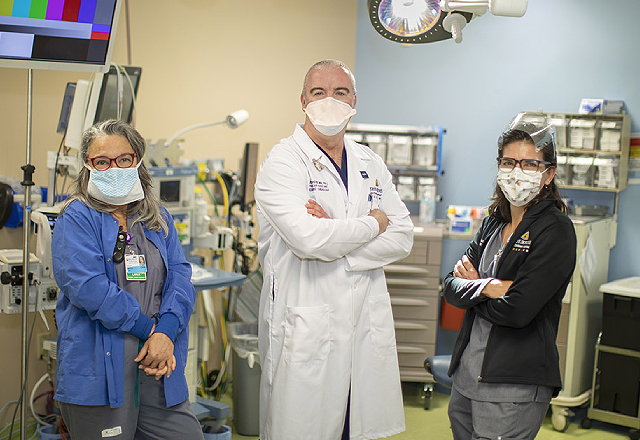Advanced Practice Providers – More Than Physician Extenders
Learn what Advanced Practice Providers (APPs) are and the roles they play in health care at Johns Hopkins All Children’s Hospital.

Grace Matos, CRNA; JP Morgan, P.A.; and Kris Rogers, APRN, CWON
An advanced practice provider (APP) plays an important role in the health care community. While this role may not be the first that people think of when it comes to those who provide patient care, these licensed and specialized providers are qualified to perform physical exams and order diagnostic tests, and some can even prescribe medications. This category of medical professionals includes:
- Physician assistants
- Nurse practitioners
- Certified nurse midwives
- Certified registered nurse anesthetists
Oct. 11-15 is the inaugural National APP Week, honoring the contributions of these professionals and raising awareness of their unique roles in health care. As Johns Hopkins All Children’s Hospital participates in celebrating their hard work, we talk with three APPs to share more about the specialized care they provide our patients.
A Career Path Meant to Be
Grace Matos, CRNA, is a certified registered nurse anesthetist and works to administer anesthesia and provide care for patients undergoing operations or procedures.
“For every child, we discuss the best anesthesia plan, and I manage the airway, monitor essential organ functions, watch and intervene, and bring the child to the end of the procedure as safely as possible,” Matos explains. “In short, I am involved with the child for every heartbeat while under anesthesia care.”
For Matos, who has worked with all different ages for most of her career, working in pediatrics was written in the stars.
“When I was providing anesthesia for obstetrics, I frequently worked with a pediatric anesthesiologist who would recruit me to give him a hand when neonatal babies had to be intubated.”
Eventually, that doctor came to work for Johns Hopkins All Children’s Hospital, and during a staff shortage, asked Matos to fill a PRN (as-needed) position.
“I learned a lot, and unexpectedly loved a lot of what I was doing. I took a full-time position years later. It was meant to be.”
Not Just “Physician Extenders”
Kris Rogers, APRN, CWON, is a nurse practitioner who is also certified in wound and ostomy care. She sees patients throughout the hospital and in the outpatient wound clinic, responding to calls for new consults, help with wound and ostomy care at the bedside and last-minute clinic appointments.
“I was initially a nurse on the post-surgical unit, which exposed me to wound care. When I joined the pain management team, I saw the need to develop the role of wound care in the hospital,” she says. “It is very rewarding to help pediatric patients and families with wound and ostomy care."
For Rogers, it never occurred to her to work in anything but pediatrics. She acknowledges that her role often involves interacting with patients and families on their worst days and considers helping to make their situation less difficult a rewarding feat.
“The APP role is expanding and not just as ‘physician extenders.’ We bring experience, knowledge and a unique skillset that can truly improve the care of patients,” Rogers explains. “I have worked with multiple health care providers, including great surgeons and physicians, and feel honored that I am able to use and share my knowledge to enhance patient care.”
The Precious Fibers
JP Morgan, P.A., is a cardiology physician assistant who works in the outpatient clinic, collaborating with his physician colleagues to provide patient care, assist with electrophysiology procedures and support the team in every way possible.
“I’m blessed to have been trained to care for people of all ages, but I prefer kids,” he says. “Cardiac anatomy and physiology have always enamored me, and it is for this reason that I chose to practice in this specialty.”
Having worked at the hospital for over a decade, he has a lot of pride in what he does and where he works.
“We are bigger in size now, but the precious fibers, the people, haven’t changed. I have walked these hallways for nearly 14 years now and still see the same faces, and I know what those faces are capable of and how much they love caring for their patients, both in the worst and best of times,” he explains.
“I am, and forever will be, proud to be part of a family that always provides the most loving, compassionate and highest quality pediatric care.”
